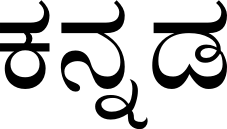Difference between revisions of "Language/Kannada/Grammar/Nouns"
m (Quick edit) |
m (Quick edit) |
||
| Line 38: | Line 38: | ||
In this lesson, we have discussed the basics of Kannada nouns. We have looked at the different types of nouns, how they are formed, and how they are used in sentences. We hope that this lesson has helped you to gain a better understanding of Kannada nouns. | In this lesson, we have discussed the basics of Kannada nouns. We have looked at the different types of nouns, how they are formed, and how they are used in sentences. We hope that this lesson has helped you to gain a better understanding of Kannada nouns. | ||
<br><hr>If you have any questions, please ask them in the comments section below.<br>Feel free to edit this wiki page if you think it can be improved. 😎 | <br><hr>If you have any questions, please ask them in the comments section below.<br>Feel free to edit this wiki page if you think it can be improved. 😎 | ||
==Related Lessons== | |||
* [[Language/Kannada/Grammar/Questions|Questions]] | |||
* [[Language/Kannada/Grammar/Future-Tense|Future Tense]] | |||
* [[Language/Kannada/Grammar/Gender|Gender]] | |||
* [[Language/Kannada/Grammar/Negation|Negation]] | |||
* [[Language/Kannada/Grammar/Pronouns|Pronouns]] | |||
* [[Language/Kannada/Grammar/Adjectives|Adjectives]] | |||
* [[Language/Kannada/Grammar/Conditional-Mood|Conditional Mood]] | |||
{{Kannada-Page-Bottom}} | {{Kannada-Page-Bottom}} | ||
Revision as of 23:05, 25 February 2023
Hi Kannada learners! 😊
In today's lesson, we will be discussing the basics of Kannada nouns. Nouns are an important part of any language, and Kannada is no exception. We will look at the different types of nouns, how they are formed, and how they are used in sentences. By the end of this lesson, you should have a good understanding of Kannada nouns.
Types of Nouns
Kannada has two main types of nouns: common nouns and proper nouns. Common nouns refer to general things, such as people, places, animals, and objects. Proper nouns refer to specific people, places, or things.
Common Nouns
Common nouns are the most common type of nouns in Kannada. They can be divided into two categories: animate and inanimate. Animate nouns refer to living things, such as people, animals, and plants. Inanimate nouns refer to non-living things, such as objects, ideas, and concepts.
Common nouns can also be divided into gender categories. Kannada has three genders: masculine, feminine, and neuter. Masculine nouns refer to male people or animals, while feminine nouns refer to female people or animals. Neuter nouns refer to things that are neither male nor female, such as objects or ideas.
Proper Nouns
Proper nouns are specific names for people, places, or things. For example, the name “Bangalore” is a proper noun because it refers to a specific city. Proper nouns are always written with a capital letter.
Formation of Nouns
Kannada nouns are formed by adding suffixes to root words. The suffixes indicate the gender and number of the noun. For example, the root word “guru” (teacher) can be changed to “gurava” (teacher, masculine singular) or “guravaru” (teachers, masculine plural).
Nouns can also be formed by adding prefixes to root words. Prefixes indicate the gender and number of the noun, as well as the relationship between the noun and other words in the sentence. For example, the prefix “a” can be added to the root word “guru” to form the word “aguru” (my teacher).
Usage of Nouns
Nouns are used in many different ways in Kannada. They can be used as the subject or object of a sentence, or as the object of a preposition. Nouns can also be used to describe other nouns, or to indicate possession.
For example, the sentence “The teacher is teaching” uses the noun “teacher” as the subject of the sentence. The sentence “I saw the teacher” uses the noun “teacher” as the object of the sentence. The sentence “The book belongs to the teacher” uses the noun “teacher” to indicate possession.
Nouns can also be used to describe other nouns. For example, the sentence “The old teacher” uses the adjective “old” to describe the noun “teacher”.
Conclusion
In this lesson, we have discussed the basics of Kannada nouns. We have looked at the different types of nouns, how they are formed, and how they are used in sentences. We hope that this lesson has helped you to gain a better understanding of Kannada nouns.
If you have any questions, please ask them in the comments section below.
Feel free to edit this wiki page if you think it can be improved. 😎
Related Lessons
